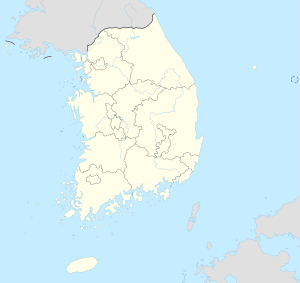Hwasun
| Hwasun | |||
|---|---|---|---|
| Korean alphabet : | 화순군 | ||
| Chinese characters : | 和順 郡 | ||
| Revised Romanization : | Hwasun | ||
| McCune-Reischauer : | Hwasun | ||
| Basic data | |||
| Province : | Jeollanam-do | ||
| Coordinates : | 35 ° 0 ′ N , 127 ° 0 ′ E | ||
| Surface: | 787 km² | ||
| Residents: | 66,900 (as of October 2014) | ||
| Population density : | 85 inhabitants per km² | ||
| Structure: | 1 Gun , 1 Eup , 12 Myeon , 188 Ri |
||
| map | |||
|
|||
Hwasun ( Hwasun-gun ) ( 화순군 ) is a district with around 67,000 inhabitants in the Jeollanam-do Province ( 전라남도 ) in South Korea . In it is Hwasun-Eup as a small town and the largest place in the district.
geography
Hwasun County is located southeast of Gwangju ( 광주시 ), in the middle of Jeollanam-do Province. It is surrounded by seven further districts, the districts Damyang ( 담양 ) and Gokseong ( 곡성 ) to the north , Suncheon ( 순천 ) to the east, Boseong ( 보성 ) southeast , Jangseong ( 장성 ) south, Yeongam ( 영암 ) southwest and Naju ( 나주 ) to the west ).
Hwasun-gun is 32 km wide in its east-west extension and measures 43 km from north to south. The district covers an area of 787 km 2 , of which 581 km 2 (73.8%) consists of forest and fields, 128 km 2 (16.3%) is used for agriculture and 78 km 2 (9.9%) is used for other purposes used area exists. Most of the landscape has the character of a low mountain range and is between 400 m and 900 m high. The only exception is the 1187 m high Mudeongsan ( 무 덩산 ).
The small town of Hwasun-Eup is located in the northwest of the district, around 12 km southeast of the city center of Gwangju.
history
Hwasun first appeared as a Hyeon ( 현 ) during the time of the Baekje kingdom, but it was not congruent with today's district. Frequent reorganizations and renaming took place during the United Silla Kingdom and Joseon Period . In May 1895 the region of today's county was divided into Neungju-gun, Hwasun-gun and Dongbok-gun. On October 15, 1908, Neungju-gun was assigned to Hwasun-gun, so that only two counties existed. In 1913 the name was changed from Neungju-gun to Hwasun-gun and the subsequent division into Hwasun-gun and Dongbok-gun. On March 1, 1914, Dongbok-gun was finally reassigned to Hwasun-gun. Since then, Hwasun-gun County has existed in the form it still has today.
On January 1, 1963, Hwasun-myeon was upgraded to a Eup (Small Town).
The county
The district has become internationally known for the numerous dolmens that are over 2,500 years old , which can be found in clusters in various places in the district. The Dolmen of Hwasun were together with the dolmens of Gochang and the dolmens of Ganghwa entitled Gochang, Hwasun and Ganghwa Dolmen Sites to World Heritage appointed.
Also of importance are the four temples Gaecheonsa ( 개 천사 ), Manyeonsa ( 만연 사 ), SSangbongsa ( 쌍봉사 ) and Unjusa ( 운주사 ), the latter being known as the Temple of 1000 Pagodas and 1000 Buddhas . This large number of pagodas and Buddha figures are said to have actually been present in this temple until the end of the 16th century. Only 17 pagodas and 70 statues have survived to this day. The largest Buddha figure that can be seen in the temple consists of two adjoining sculptures carved out of stone, which if put up would have a height of 10.26 and 12.7 meters respectively. The temple can be found 26 km southwest of Hwasun-Eup.
Also worth mentioning are the Dogokoncheon hot springs, which have been used for tourism since 1989. Baths, hotels and restaurants have sprung up around the springs.
See also
Web links
- Homepage . Hwasun County,accessed November 4, 2015.
Individual evidence
- ↑ a b Size, Administrative districts, Households, Population . Hwasun County , accessed April 15, 2018 .
- ↑ a b location . Hwasun County , accessed April 15, 2018 .
- ↑ Tourist guide pamphlet . Hwasun County , accessed April 15, 2018 .
- ↑ a b History . Hwasun County , accessed April 15, 2018 .
- ↑ a b Gwak Jae-gu : Hwasun - A peaceful place full of mystical energy . In: The Korea Foundation (Ed.): Koreana - Korean Art and Culture . Volume 10, No. 3, autumn. Seoul 2015, p. 56-58 .
- ↑ Unjusa Temple . Hwasun County , accessed April 15, 2018 .
- ↑ Dogokoncheon Hot Spring . Hwasun County , accessed April 15, 2018 .

